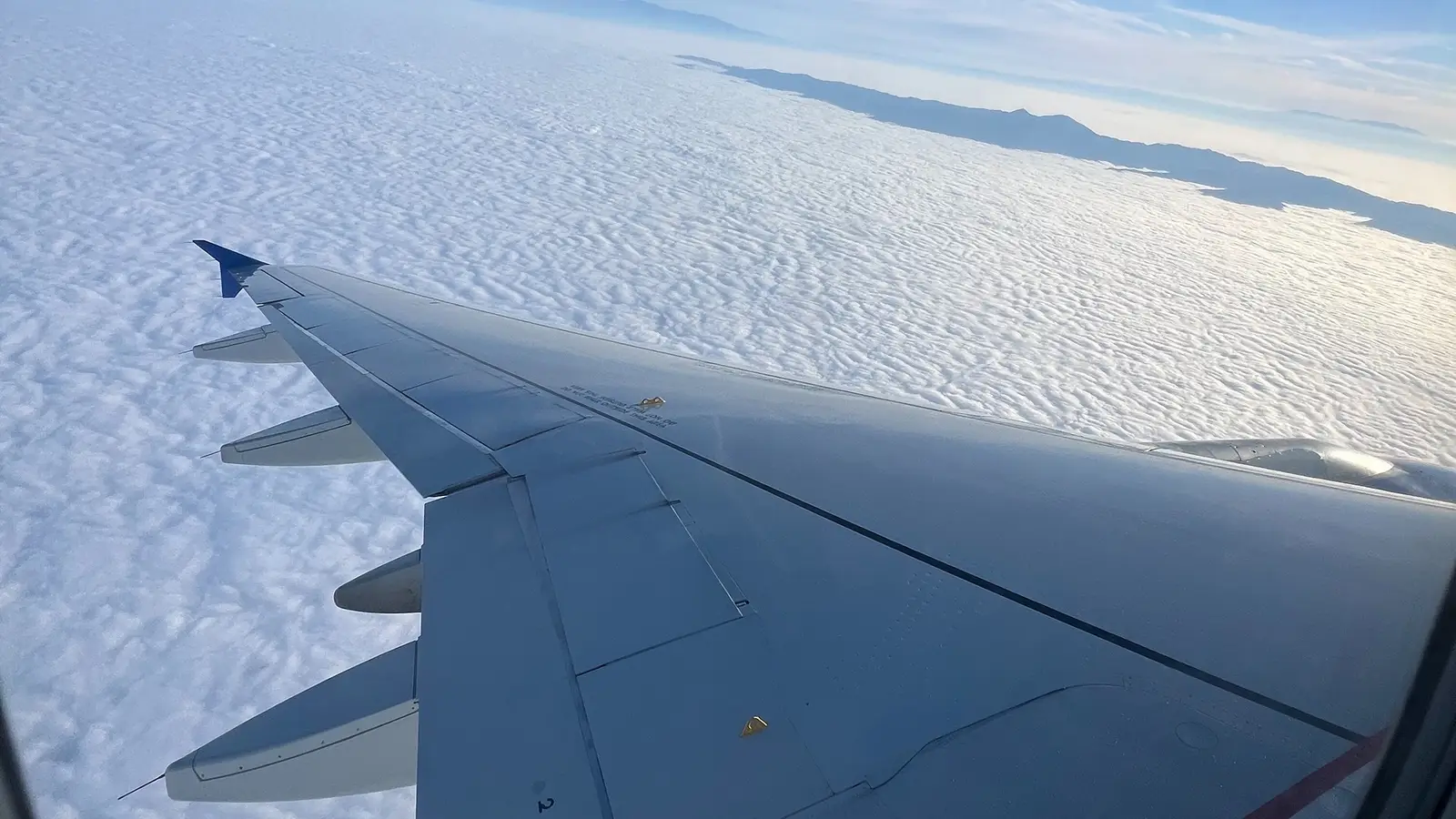
Pilots go through the same bumpy turbulence as passengers, but they see it in a completely different way. They spend hundreds of hours learning exactly how much motion an airliner can safely absorb in classrooms, simulators, and small aircraft, long before they ever carry passengers. Manufacturers subject the aircraft to artificial gusts that are far rougher than actual weather, bend the wings until they break, and slam them down as part of certification testing.
Pilots and air traffic control have technology to predict the beginning and end of rough air using real-time radar, satellite imagery, and ride reports from other crews. When they can’t simply go around, pilots decelerate to the turbulence penetration speed. That number is set to reduce ride harshness and structural stress, but there’s rarely any risk.
Keeping Calm In The Cockpit
Even unexpected pitch or roll changes appear insignificant to pilots seated at large forward windows with an unwavering horizon. With knowledge, training, experience, and a good seat, it’s more like riding ocean swells than hitting potholes on the flight deck. But when the floor drops, passengers’ inner ears signal “we just dropped” and the sensory mismatch with the visuals in the cabin can make the feeling even more disorienting.
Detachment is largely created by training. Simulator flights purposefully include severe-turbulence scenarios for pilots to practice controlling the airplane during weather-induced altitude deviations. They learn to manage the plane while operating the radios as the virtual cockpit bucks around them. The task becomes routine after a few repetitions: wait it out, keep the wings level, and adjust attitude (the plane, that is) if needed.
The majority of the turbulence encountered in daily commercial flying is light to moderate, which is well within the limits of a jet like a Boeing 737 MAX 8 that has digital autopilot and a flexible wing structure. Pilots are not unaffected by turbulence, but they prepare for it, keep an eye on it, and steer clear of the worst of it. They are not alarmed since they know from experience, training, and engineering data that it is more of a discomfort issue rather than a safety hazard.
Perception Isn’t Always Reality
Turbulence can be dramatic because the eyes perceive a stationary cabin that should be motionless, but your inner ear perceives rapid, random motion. In actuality, an airliner only experiences brief, minor changes in attitude and g-load when flying through rough air. These forces hardly change its course at all in most cases and are well within the bounds that the aircraft is tested to withstand by 2025 standards.
Modern jet designs are designed to withstand gust loads that are far stronger than anything crews would encounter while flying. Manufacturers test prototype airplanes by bending their wings upward until they fail in a destructive test, long before passengers ever board, to prove the safety margins. The wing and tail of a civil airliner must be able to safely withstand at least 2.5 G positive load. As this informative analysis on Aviation Stack Exchange dives into, that is 150% of the maximum expected load, plus a significant safety factor.
Engineered For Rough Skies
To prevent the worst turbulence in the first place, pilots and dispatchers plan and use every resource at their disposal. On-board weather radar identifies storm cells that need to be avoided, satellites outline weather front boundaries and mountain-wave clouds, while ATC broadcasts pilot turbulence reports in real time.
Advanced computer models forecast the probability of clear-air turbulence along jet routes. When major turbulence is predicted, routes and altitudes are adjusted during the planning phase. Pilots use that data inflight to request an altitude change or a small course deviation when something new pops up, usually long before the cabin is ever rocked.
Still, turbulence has a negligible impact on the aircraft even when it cannot be avoided. Forces of plus or minus a half-G might be momentary during a moderate encounter. That’s just enough to shake drink carts but falls well short of any danger to the plane. Jets are made with positive stability that exploits natural physics to keep the plane on course. Modern avionics automatically revert to a programmed attitude, and any remaining oscillation is smoothed out unless the pilots do it themselves.
For instance, there are only a few dozen severe turbulence injuries to airline passengers in the United States each year, and nearly all of these incidents involve an unbuckled passenger or a working member of the cabin crew. In the jet age, structural damage that results in the loss of an airliner due to turbulence alone is unheard of. Today’s aircraft are over-engineered, the crew is well-trained, and the flight plans are designed to account for turbulence. Despite their annoyance, the bumps pose no greater risk to the aircraft than potholes do to a city bus.
The Different Kinds Of Turbulence
In areas that are otherwise cloud-free (or have clear air), there is sometimes still significant wind shear, either horizontally or vertically. Since there is little to no moisture, it is difficult to see on radar, and crews rely on ride-quality sensors, forecasts, and reports from other aircraft (PIREPs). Clear-Air Turbulence (CAT) typically occurs between 20,000 and 40,000 feet, near upper-altitude wind shear zones, jet streams, and tropopause winds.
Thunderstorms create convective winds in the tropics, a turbulence that occurs in and around cumulonimbus (CB) clouds from the ground up to 60,000 feet or more. It feels like gusts from ahead and microbursts below, with strong up and downdrafts from the thunderstorm. These are usually avoidable by using visual cues, on-board weather radar, and ATC gives detours (20 NM or more) around severe cells.
Thermal (fair-weather) turbulence is common at low to mid-level altitudes (surface to ~10,000 ft) on sunny days, especially over land. The uneven surface of the terrain below creates rising thermals beneath cumulus clouds and sinking air in between. Commonly experienced by glider pilots (soaring in thermals) and often felt by general aviation pilots in light aircraft on summer afternoons.
Mechanical turbulence typically occurs near the ground, often below 2,000 ft (610 m) AGL, downwind of obstacles like big hangars, urban skylines, or rough terrain. Wind flowing over and around those objects breaks into eddies and vortices. A common case is a bumpy final approach on a breezy day at an airport surrounded by buildings or trees.
Vortex Wake Turbulence is created below and behind airplanes, but it is most noticeable behind large, clean, slow aircraft (like an A380 on final). Lift-generated wingtip vortices that settle and float with the wind disrupt the air temporarily. This kind of turbulence can be prevented by using pilot techniques, air traffic control spacing, and crossing the flight path above the other plane’s altitude.
Orographic, or Mountain-Wave, turbulence occurs from ridge top height up to the lower stratosphere (sometimes > FL450) on the lee side of mountain ranges. Stable air forced over steep terrain and high elevation creates it. Tell-tale signs include lenticular (lens-shaped) clouds aloft, rolling clouds near ridges, and strong wind perpendicular to the range.
Frontal turbulence typically occurs below 15,000 feet, close to the boundaries of cold-front and occluded-front weather systems. Along the warm weather front are convective air, wind shear, and upward air flow. It is usually not more than moderate in intensity.
Low-Level Wind-Shear (Microburst) Turbulence can happen during final approach or initial climb out (surface to ~1000 ft) near thunderstorms or under strong air currents. It causes a rapid change in wind speed and/or direction over a short vertical or horizontal distance. Ground-based systems and Doppler radar alerts help pilots locate it in advance.
The Silver Lining Of Storm Clouds
A thermal bump and a mountain-wave encounter can both be moderate, while a CAT near a polar jet or a microburst can reach severe to extreme. Reports describe both the type and the intensity. Most airline turbulence is light to moderate, and dispatch accounts for this level of turbulence. When seat belts are worn, turbulence discomfort rarely turns into danger because modern jets are designed with high structural safety margins.
Airliners can actually benefit from turbulence in some odd cases. It may allow the crew to ascend to higher, more fuel-efficient altitudes earlier than first assigned. A jet stream shear zone is typically bumpy, but it may also indicate that the aircraft is near a strong tailwind and a small course change may save time and fuel.
A British Airways Boeing 747, Flight 112, completed a flight from New York John F. Kennedy International Airport(JFK) to London Heathrow Airport (LHR) in just 4 hours and 56 minutes, which was 80 minutes ahead of schedule in 2020. This is more than an hour faster than the average flight time of 6 hours and 13 minutes for the airline’s planes over the last 30 days.



